The robot revolution: the US Army intends to arm remotely controlled vehicles
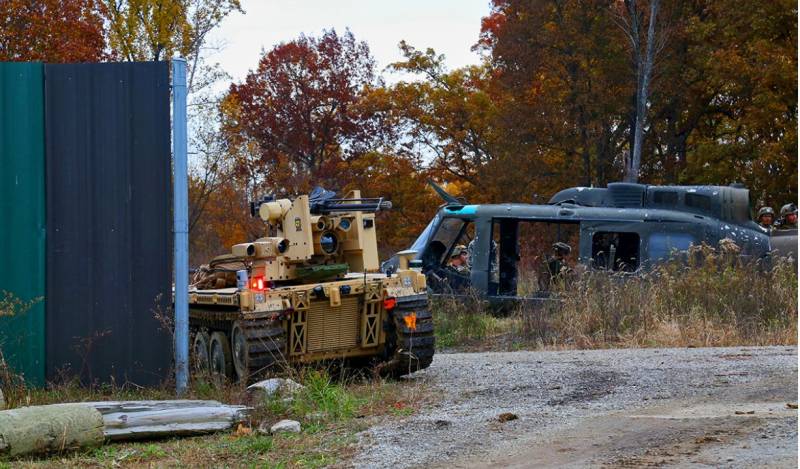
Pratt Miller's remotely controlled EMAV vehicle (pictured during initial tests of the US ILC), equipped with a QinetiQ control kit, will become the base for the RCV-L prototypes that will take part in the tests of the second stage of the American army
The plans of the US armed forces to embed robotic machines into the structure of their ground forces will largely depend on the results of the three experiments and the reliability of the communication network. Let's see how the robotic war machine program is progressing.
The US Army is preparing a fleet of new experimental remotely controlled vehicles (ROVs) for a series of exercises over the next few years. Their goal is to assess the level of effectiveness of such systems, which would allow the army to begin a new development and procurement process with the aim of officially adopting robotic combat vehicles (RBM) for supply.
Army commanders are optimistic about the potential of a combination of sensors and weapons equipped with SAMs and a reliable communication network and are ready to rethink tactics, methods and methods of warfare.
Robot revolution
«Robots have the potential to revolutionize the way ground combat operations are conducted,” said Ross Kofman, head of the Next-Generation Combat Vehicles Cross-Functional Team (NGCV CFT). “Besides the fact that they will increase the firepower of a dismounted patrol trying to dislodge the enemy from a position or conducting RCB reconnaissance, we believe that such vehicles will give commanders more time and space to make decisions and reduce risks for soldiers.”
The Army has launched a Robotic Combat Vehicle (RCV) program that is exploring ways to integrate unmanned combat vehicles into ground forces.
The goal is to determine the need for robotic capabilities in a series of virtual and real experiments so that an official program for the development and procurement of light and medium variants can be launched by 2023, and subsequently to take on a heavy tank-like model.
The Army will increase investment in its BSR project over the next five years by 80%, from $ 420 million in its five-year plan, which began in 2020, to $ 758 million in the forward-looking plan included in the 2021 budget request.
By investing new technologies in the form of prototypes in the hands of soldiers and working closely with industry, the army plans to develop principles of combat use and a doctrine of interaction between robots and personnel, in fact, a theory of joint actions of inhabited and uninhabited platforms. The army hopes that the project will identify new methods of warfare, assess the limitations and advantages of new RBM technologies, and possibly start producing a new class of combat vehicles.
Fantastic Four
The RBM is one of four main projects in the portfolio of the complex group, which also includes: the optional Optionally Manned Fighting Vehicle, which will replace the Bradley BMP; lung project tank Mobile Protected Firepower (MPF) for infantry units; and the universal armored vehicle Armored Multi-Purpose Vehicle, designed to replace the M113 armored personnel carrier.
The army, having decided on a preliminary set of requirements, currently sees the need for three versions of the BSR - light, medium and heavy. “I believe the army is serious about experimenting with this class of vehicles. In theory, we know our requirements, but we don't know them in practice until we pull all these systems into real conditions, ”said Major Corey Wallace, BSR project manager in the integrated group.
The lightweight RCV-Light (L) platform should be primarily equipped with sensors capable of coordinating with other weapon systems for convincing fire effects on targets. "The military wants to get a small expendable platform that can perform a maneuver with relative advantage, quickly provide the commander with information about the situation, and enable him to use all suitable firepower on selected targets," Wallace said.
The larger medium platform RCV-Medium (M) is seen as a low-cost platform that requires minimal maintenance.
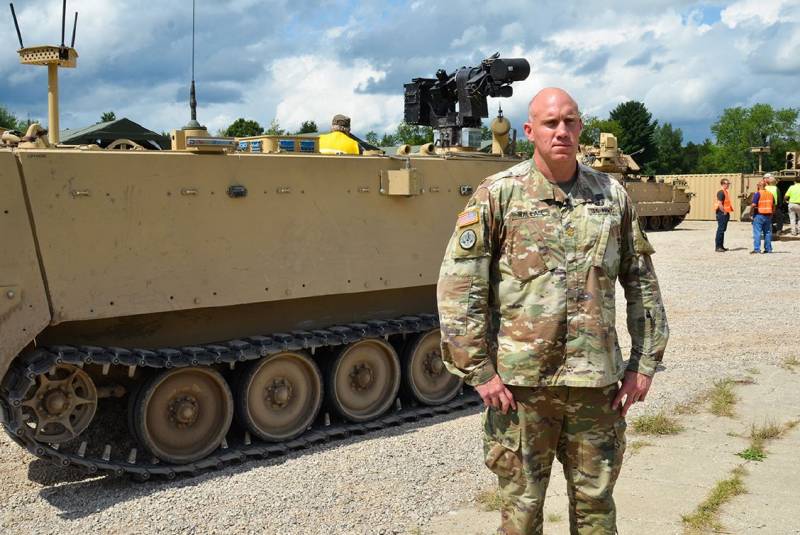
Major Wallace of the NGCV CFT group stands in front of the M113, adapted for use as a dummy RBM and equipped with special weapons and sensors.
The army envisions the RCV-M as a direct-fire platform with more power and a larger volume for modular target loads. Platforms of both classes will have a common chassis so that the commander has the opportunity to configure the RBM for the needs of a specific task. “The RCV-Heavy (H) platform is planned to give the soldiers what they need,” Wallace said. - It has the same firepower as a crewed armored vehicle. It will maneuver in tandem with a crew tank or armored personnel carrier and provide decisive firepower from a vantage point. "
Dependent relationship
The BSR program will make full use of the groundwork gained over decades of scientific and technical work of army specialists in the field of ground robots. But the army is not looking for fully autonomous systems. "They will never be completely autonomous," Wallace said. - Complete autonomy means that people are not needed at all. There will always be a person in the control loop, at any given moment, especially with regard to endowing the RBM with the ability to fire at targets. A robot will never be able to give itself permission to engage in combat, to use its weapons and protective equipment.
However, new systems will be allowed to defend themselves regardless of the operator's actions. RBMs will, for example, be able to intercept attacking RPGs with their active defense systems.
The Army has defined a "BSR Campaign Plan," which calls for three main real-world experiments (each preceded by a pair of virtual experiments) to refine their plans for robotic machines.
The plan is divided into three phases with progressively increasing difficulty in maneuvering vehicles and soldiers while expanding the capabilities of prototype platforms.
During its implementation, a number of new technologies were used with the aim of adopting large remotely controlled platforms for the ground forces. The first of these is the deeply modernized Bradley BMP, designated MET-D (Mission Enabler Technology-Demonstrator - a technology demonstrator that can help in the task). These BMPs will become the base platforms for soldiers in control of unmanned combat vehicles.
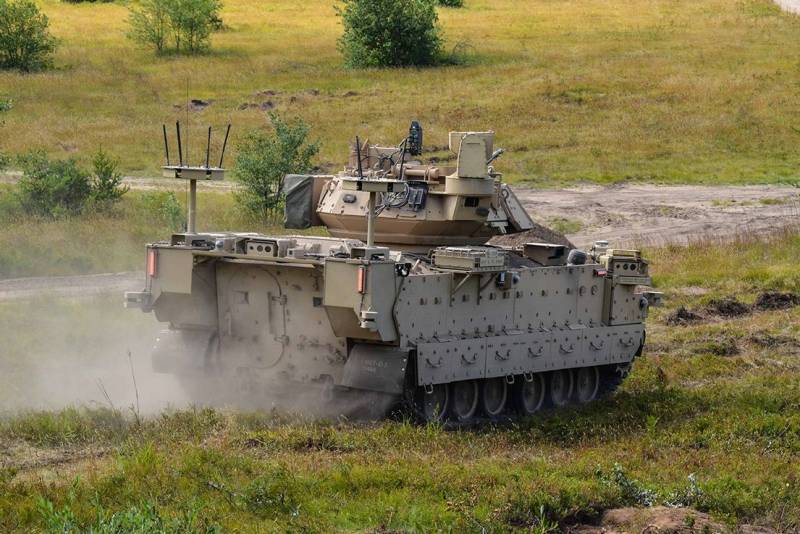
A deeply redesigned Bradley vehicle, modified to a MET-D configuration, will serve as a base platform to house four control stations for BSR soldiers.
The MET-D program of the Detroit Arsenal Ground Vehicles Center is funded by the Army Advanced Projects Agency. Prototypes are equipped with the most advanced subsystems, including a camera system around the vehicle, improved crew seats with touch screens and a remotely controlled turret with a 25mm cannon.
These armored vehicles provide protection for the workplaces of operators operating BSR platforms. In addition, the army intends to use MET-D as a test bed for experimenting with new technologies, in particular to promote projects created in government laboratories or industry, that is, promising functional prototypes that can accelerate the implementation of these technologies. In addition, this could be helped by information from the soldiers participating in the experiments, justifying the need, as well as determining the directions for further improving the projects.
Layout stage
For stage 1 of the RBM project, the army integrated remote control into the BTRM 113, converting them into running models of the RBM for initial experiments. “Phase 1 will validate the concept of co-operation between inhabited and uninhabited platforms,” Wallace said. "The goal is to start developing basic tactics, methods and methods of warfare that the army will use after adopting robotic machines, as well as further expanding and confirming the concept of robotic warfare."
In early 2020, even before the coronavirus rush began, the army planned a month-long experiment in Fort Carson in March and April with the participation of a platoon from the 4th Infantry Division, providing its soldiers with two MET-D dummies and four RBM dummies based on M113. In the spring, the experiment was postponed indefinitely.
These specially modified M113 vehicles are equipped with a remote-controlled weapon system, including the Picatinny Lightweight Remote Weapon Station turret and an electric 7,62mm machine gun.
Two of the four BSRs are equipped with advanced situational awareness tools, including a target detection and recognition system, as well as an advanced third-generation long-range surveillance system. In addition, these two vehicles will be equipped with an enemy fire detection system and a set of situational awareness cameras. The program provides for the conduct of initial unmanned maneuvers with the soldiers driving the RBM mock-ups by means of telecontrol with continuous control of the vehicles.
The Phase 1 experiment will focus on reconnaissance missions to demonstrate basic obstacle detection and avoidance at speeds of 32 km / h on road and over 16 km / h off road. It is planned to move on paved roads, dirt roads and semi-autonomous control in open areas. It is also expected to work with RBM in light dusty conditions, during rain, snow and fog.
Each MET-D platform will initially be equipped with four RBM control stations - two for motion control and two for weapons control. The modified Bradley vehicle will also be modified for wire-guided control, an electronic control kit and a laser detection and ranging kit for optional crew operations. In addition, the army plans to experiment with helmet-mounted displays while driving with closed hatches.
Planned tasks include route and area reconnaissance, obstacle surveys and cover. In the final part of the experiment, the MET-D and BSR mock-ups should demonstrate a “future scenario” that includes decentralized scheduling and execution of tasks, driving with closed hatches with a crew of two, and assessment of maneuvers with a maximum BSR control cable.
In addition, this last step will assess how SSR units operate with the latest technologies and tactics of modern warfare, including aggressive low-flying drones, electronic countermeasures, high-precision targeting and signature control.
“We're trying to solve simple problems in the first place,” Wallace said. "And then move in a spiral: the experience that we received in the previous experiment, build in the next experiment."
Spring Campaign
The Army will then begin work as part of Phase 2, scheduled for spring 2022, in which the experiment will expand from a platoon demonstration to a company demonstration.
The 2022 event will focus on expanding the synergy between inhabited and uninhabited platforms, as well as increasing the autonomous capabilities of robotic platforms. The 2022 experiment will involve six MET-D platforms that will control a dozen BSRs.
In the Phase 2 experiment, the set of tasks will change, reconnaissance will give way to the organization of offensive and defensive actions, including the demonstration of making passes at once using a certain type of robotic capabilities - either demining with a small robotic platform or a special armored vehicle for making passes. The experiment is also planned to conduct remote chemical reconnaissance using sensors installed on one of the robotic platforms.
“Clearing passages and scouting for poisons are two of the most dangerous tasks our soldiers perform,” Wallace said, adding that outright clearance is one of the most risky and difficult maneuvers a mechanized force can perform.
Rapid prototyping
In January 2020, following an RFP from industrial enterprises for an expedited delivery of BSR variants for Phase 2, the Army selected QinetiQ North America to build four RCV-L prototypes and Textron to build four RCV-M prototypes.
The RCV-L platform is based on the Pratt Miller Defense Expeditionary Modular Autonomous Vehicle (EMAV), originally created for the Marine Corps Combat Laboratory. The RCV-L variant is a combination of Pratt Miller's EMAV chassis and QinetiQ control systems. The company points out that this proven platform has good characteristics, as a result of which the risks of falling behind the delivery schedule and getting unsatisfactory characteristics are seriously reduced.
- explained the representative of QinetiQ.
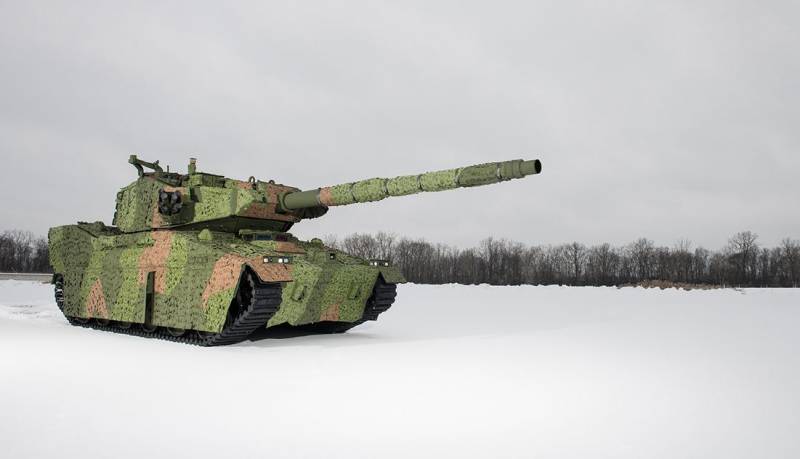
The development of the RCV-H faces a number of technical challenges. One of the solutions could be the choice of platforms manufactured by BAE Systems (pictured) or GDLS for the MPF program
A Pratt Miller Defense spokesman added that he “has no doubt that EMAV will exceed the expectations of the US Army's experimental group. Corpus Labs have independently experimented with the EMAV over the past two years and the results have been phenomenal. Our main goal is to provide the US Army with a proven platform to experiment with without worrying about the capabilities of the technologies integrated into it. ”
For its part, Textron has teamed up with the small tracked vehicle manufacturer Howe & Howe Technologies, as well as FLIR Systems, to offer the army an RCV-M variant based on the Ripsaw M5 vehicle. The company calls it "a fifth generation robotic platform, which combines stackable armor, reliable suspension and power drives that allow you to solve a variety of tasks."
Although these two contracts give the winners the opportunity to help the army formulate the requirements for the BSR, the matter is unlikely to be limited to them. “I don't think this is the end of the competition. We also have contracts for prototypes and demonstration samples for testing, ”Wallace said. He noted that innovative activities in other branches of the armed forces could affect the future plans of the army. For example, this is the Marines' Rogue Fires program, under which a High Mobility Artillery Rocket System will be installed on an unmanned Joint Light Tactical Vehicle.
Difficult task
Phase 3, which will carry out the final real-world experiment, is slated for the spring of 2024. It will assess the possibility of using uninhabited combat platforms to perform the most dangerous task - a combined arms breakthrough.
“A combined arms breakthrough is usually the maneuver that can cause the greatest losses for mechanized forces,” Wallace said. - It is also the most difficult because it requires good synchronization of actions. You try to synchronize direct fire, you try to synchronize engineering assets, synchronize your forces and assets that secure the flanks, fire to suppress and then launch an attack. That is, it is a very risky, very difficult business. For RBM platforms, the principles of combat use and tactical techniques should be developed that would make it possible to fully use their potential. After all, you must not only get through the obstacle, you must also break through the enemy, which is in prepared defensive positions, ”said Wallace, emphasizing the complexity of the tasks included in the last three planned experiments.
According to the army, at the third stage, when working with prototypes of the RBM, the experience gained in the first two experiments will be used, various approaches will be studied to solve emerging problems. Current plans include the study of new modular target loads for innovative uninhabited platforms. The goal is to issue at least two contracts for the design and manufacture of 12 new BSR platforms for participation in the experiment, scheduled for 2024.
Phase 3 platforms will focus on firing missions, with an emphasis on remote work and the integration of automatic weapons, missile systems and advanced sensors. The software for such modular subsystems as, for example, the smoke screen, the electronic warfare subsystem, chemical-biological and reconnaissance sensors will be improved and integrated.
As part of its BSR project, the Army has issued a so-called “Preliminary Capability Development Document” which includes an estimate of the total number of platforms purchased based on various factors such as average cost per vehicle and total life cycle cost. Typically, such a document will not be finalized until after the official launch of the Milestone B program, currently scheduled for 2023.
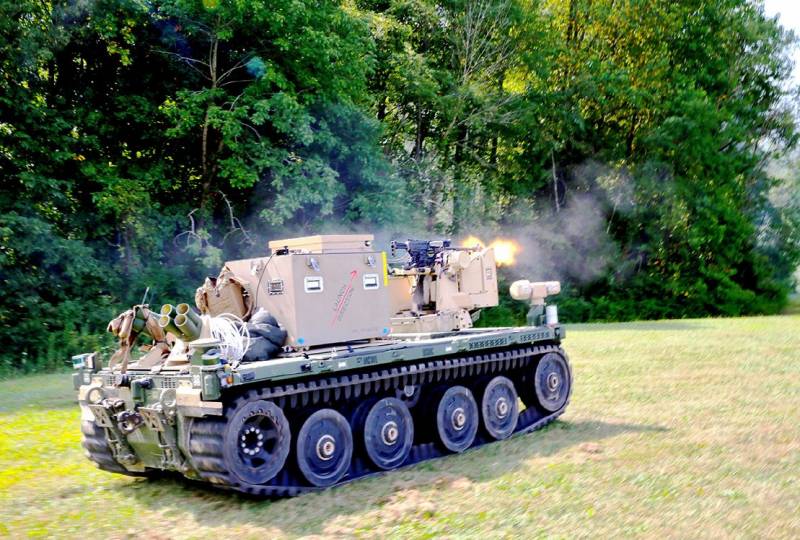
The choice of platforms for initial testing does not mean that companies that have already delivered their prototypes will receive contracts for serial production.
“After each virtual experiment, after each natural experiment, we take the documents with the requirements, update them based on the information we receive from the soldiers and the test results. By the time we reach Milestone B, these requirements will have been reviewed by the soldiers, verified in real-world testing, and then through a regular approval process. We will have a complete set of requirements when Milestone B starts, ”Wallace said. - The army wants to be the first to launch either the RCV-L project or the RCV-M project. The most mature and finished platform will arrive at Milestone B in 2023.
Weight problems
The RCV-H project, unlike other options, is still very far from being realized. “There are many problems that we have to solve in this difficult option project. For example, we want it to be as resilient as a tank, but it weighs 30 tons, ”Wallace said. This is an ambitious target as the current Abrams tank weighs 72 tons.
In anticipation of working out technical problems for the RCV-H platform, for example, the development of an automatic loading system for a 105-mm or 120-mm main cannon, which would be comparable in speed to the speed of the crew, the army plans to solve various organizational and doctrinal issues. “But we can include many questions in virtual experiments. We don't want to wait for technology to fall into our hands. "
While army commanders do not publicly discuss the RCV-H's development and procurement strategy, some in the industry see potential candidates in the MPF (Mobile Protected Firepower) program, which will develop a light tank for infantry units. In December 2018, the army chose General Dynamics Land Systems (GDLS) and BAE Systems, which will produce twelve MPF prototypes, respectively, based on the British Ajax chassis with an M1 Abrams turret and on the basis of the M8 Armored Gun System.
“The Mobile Protected Firepower program has some good potential,” Wallace said. - But one of the questions is very important - do the selected companies BAE and GD have relevant experience in developing unmanned operations or robotic tethered platforms. If they have it, then it will only benefit the cause and the implementation of the chosen MPF project will gain much needed momentum. "
The need for the network
Although the BSR program is actively testing the technology and demonstrating the potential of robotic capabilities aimed at increasing the fire efficiency of ground forces, the final fate of the project lies in the hands of developers and experts in the field of communication technologies.
“The biggest problem we have is with the network,” Wallace said. “To be honest, we could have the best platforms in the world, the best and latest helicopters, the best and latest artillery assets. But all this will not cost anything if there is no network. Secure digital transmission of data, excellent resistance to hacker attacks, resistance to electronic suppression, independent choice of means of countering electronic warfare or cyber attacks. This is what is extremely important and necessary for us. "
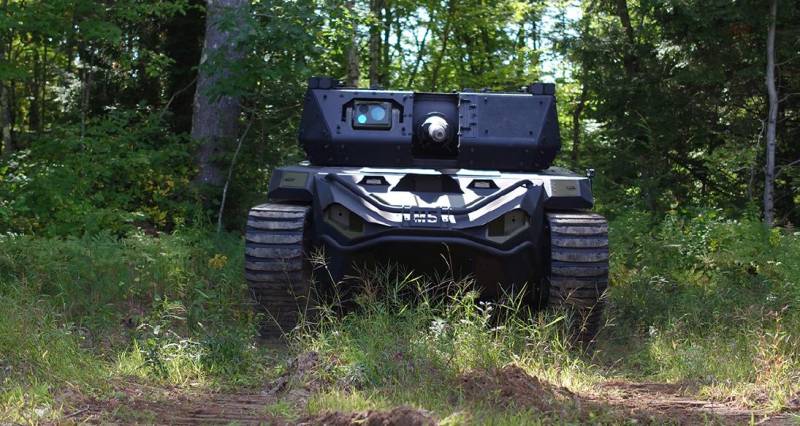
Information